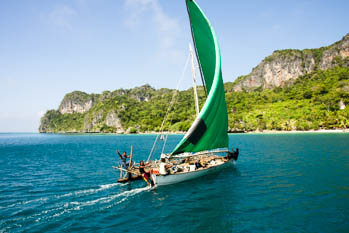
Tenaya
August
2013
Part Three
Sailing Canoes in the
Louisiades, PNG
| |
| HOME |
| About Tenaya |
| About Us |
| Latest Update |
| Logs from Current Year |
| Logs from Previous Years |
| Katie's View |
| Route Map |
| Links |
| Contact Us |
![]()
August 31, 2013
Each time we approach an island in the Louisades we see sails. Not the tall, white sails typical of yachts, but low, long, canted square sails in an array of colors and, as it turns out, materials.
In the chapter about voyaging canoes in his book, We, the Navigators, (second edition 1994) David Lewis writes, "In most places, however, traditional sailing vessels are being rapidly eclipsed. The 30-foot double canoes of the Papuan Mailu still trade to the Trobriands under sail. Elsewhere, apart from the Central Carolines, the fleets have vanished into memory."
Clearly Lewis did not visit the Louisiades.
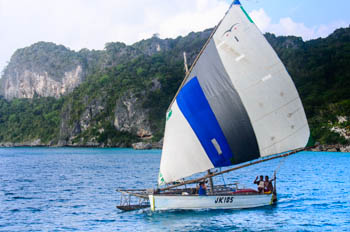
There are over 100 islands in the Louisade Archipelago. It is 200 km southeast of the Papua New Guinea mainland and bound by the Solomon Sea to the north and the Coral Sea to the south. The islands, most of which have fringing coral reefs, are scattered over 26,000 square kilometers.
Very few of these island have stores. Only one sells fuel. When people want to visit another island they take their sailau. They travel to trade, take their kids to elementary and secondary school, buy things and sometimes just to play 'Games' on Saturdays.

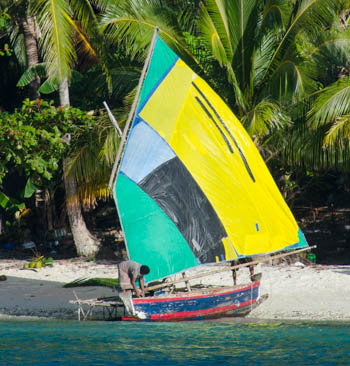
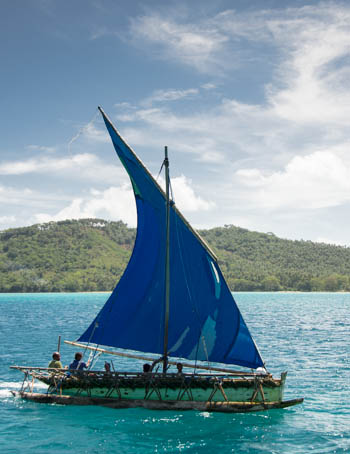
We did not want to risk going through the shallow reef into the anchorage at Brooker so people from that island sailed over to Panasia to trade with us. They would drop their sails and paddle up to Tenaya with a person at each end.
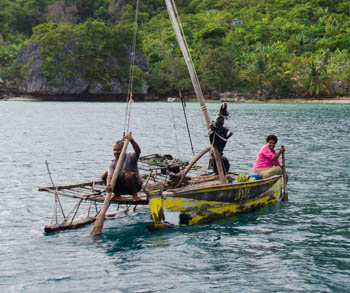

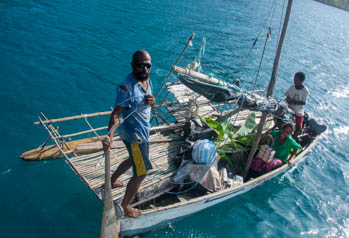
Sailaus, as sailing canoes are called in Misima, the common language of these islands, are hand hewn wooden outrigger canoes with one mast. Sails are suspended between a yard and a boom almost the length of the mast. They are made of nylon, plastic or canvas tarpaulins, or bits of rice bags sewn together. Often they are a combination of materials.
In enough wind, sailaus can attain speeds up to 15-18 knots. Often people sail 10-30 miles but sometimes travel all the way to Port Moresby. That's over 300 miles!
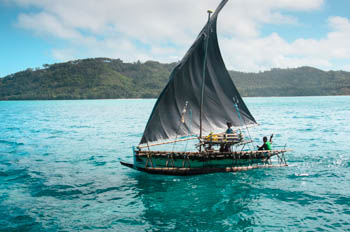
All sailaus built in the Louisiades are the same design, a single deep-V hull balanced by an outrigger. Most are constructed on Panaeati in the Deboyne Group, but some are built on Panapompom, the island right next to it. They are built by master builders to the specs of the new owners. Builders are paid in kina (local money) abalagas (ceremonal axe-like carvings) and trade goods such as food and crafts.
All have a platform but some have an additional shelf. They have uniquely carved and painted end caps at each end of the hull. No two are identical.
Canoes vary in length from 5-12 meters and are measured by outstretched arms. So a 'five-arm' canoe is about 9 meters. The main hull is about 1-1/2 meters wide and the total width, with outrigger is about 3 meters.
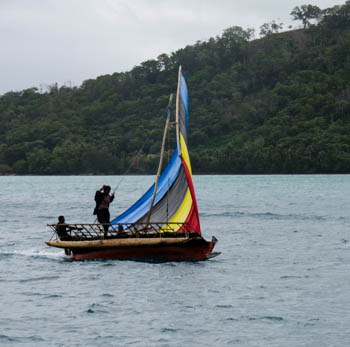
The sails may be called 'dipping-lug rigs,' but those usually only have the top yard and no boom. The boom and yard are made from bamboo or other long, straight wood. The sail design is different than any of the ancient sail types. John on Panasia said they modified their sail designs after seeing European sailing boats. Actually they were copied from Australian pearl luggers by a Brooker islander working in Queensland. The design spread from Brooker to Panaeati in the 1930s.
Like canoes from Polynesia and Micronesia, these in Melanesia have always had identical ends. To change direction, called 'stunting' rather than 'tacking,' the boom is untied from the bow. Then the mast is raked toward the new bow, the sail is swung around the mast and the boom reattached. The long steering paddle moves to what is now the stern. The outrigger is always to windward and acts as a balance weight.
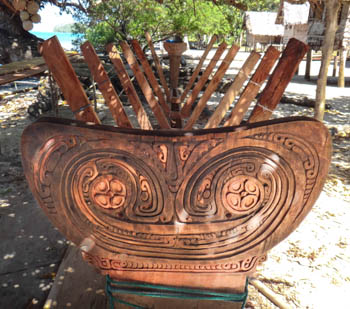
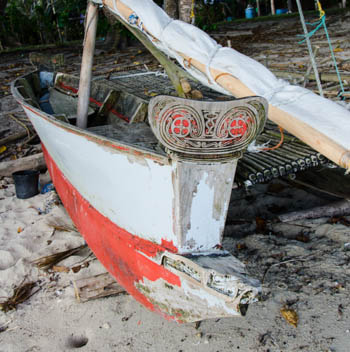

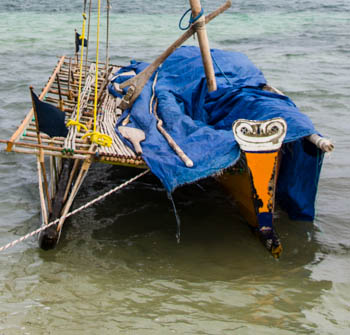
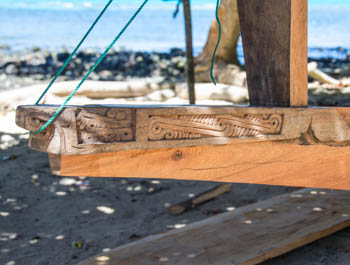
Sailing canoes have different names, depending on their size: sailau dory (length 5.3-6.4 meters, hull width 0.85-1.0 meters, overall beam 2.1-2.65 meters); sailau (length 7.0-8.4 m, hull width 1.05m-1.35m, overall beam 2.7m-3.35m); and sailau bwabwatana (length 8.9-10.2m, hull width 1.25-1.4m, overall width 3.3-3.6m).
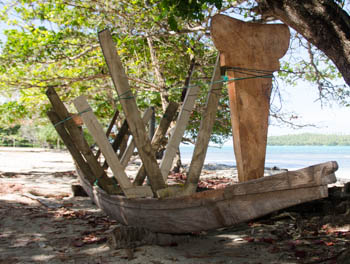
The wood used for sailaus is called malauwi in the local language. It comes from Panaeati Island although these are being built on Panapompom. Usually a sailing canoe is made from two malauwi trees. A single tree makes the curved keel for the main hull (below) carved and hollowed out exactly as a dugout canoe would be built. Another tree is used for the frames and the straight planks of the hull. This planked construction is an ancient design.
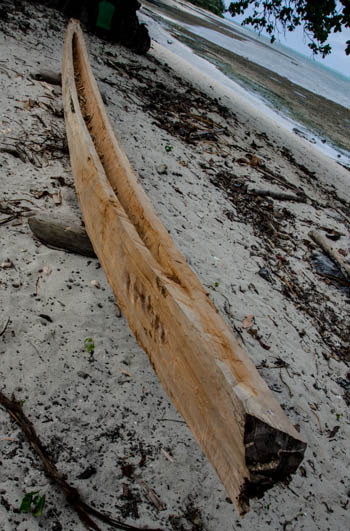
From each frame a round beam, about 35 mm/1.5 inch wide is lashed to the hull to support the outrigger which is the same length as the hull. It is made from a breadfruit tree and is lashed to the beams using crossed sticks.
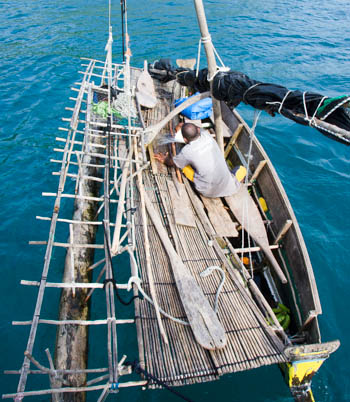
A two-part platform is made of slender sticks from a special wood chosen for stength and flexibility. It is lashed to the cross beams. The sticks are all the same size and carefully sanded. Knots at the ends are critical to performance and must be tied precisely. Joseph tells Jim that if one isn't right he must stop at an island to adjust it.
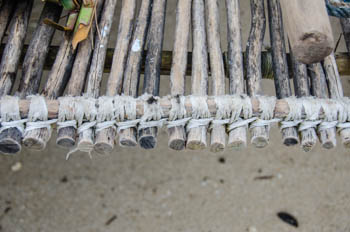
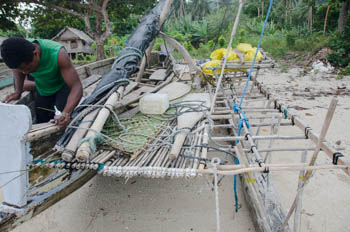
.
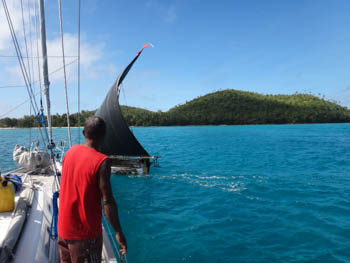











"How long do sailaus last?" Jim asks as he looks at Joseph's worn boat. "About 20 years," says Joseph. "How old is this?" "20 years." Right. Joseph is brave to have sailed his leaking, separating sailau 35 miles over the Solomon Sea.
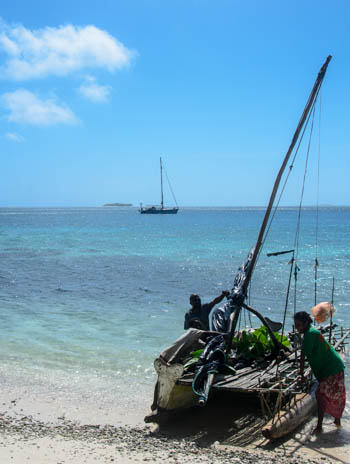
To be fair, all sailaus and canoes leak. Each one has a make-shift bucket cut from a plastic bottle to bail. It is a common sight to see streams of water being tossed over the side by one person as another steers or paddles.
Joseph needs to repair his canoe before he can return to Brooker. Until Jim helps him, the sailau has no screws or bolts. The pieces are constructed so they interconnect, reinforcing each other. Rope made from vines helps hold other parts together. Today small synthetic line may be used as well as copper nails for the hull planks. A special sealant is made from the meat of a tree to seal all the joints. Joseph's sailau is one of the few we saw that had battens in the sail.
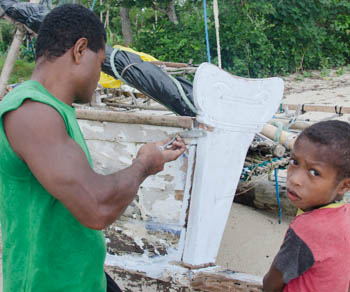
John greeted us when we arrived at Panasia. The next day he and his son sailed their sailau to Brooker Island, ten miles across the lagoon. There they picked up a few other people and transferred to HEX, Juda's large sailau which pushes 40 feet and carries 20 people. The next day they sailed to Bwagaoia on Misima. They made it faster than we would have on Tenaya. A few days later they sailed HEX back to Panasia.
John had his sailau built on Panaeati a few years ago. He paid two abulagas for it and named it JKIDS after himself and his children - John, Kanon, Immanuel, Dorothy and Sevolina.
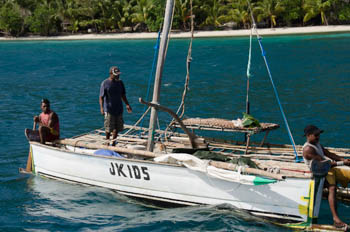
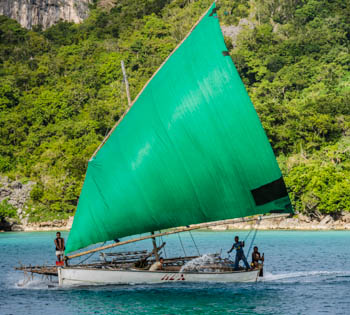
Now Tenaya is anchored near the resort on Nusa Island across the channel from Kavieng in New Ireland Province. It is a five day sail from the Louisiades.
The resort is a comfortable place with bungalows made of bush material scattered over the water and under tall, leafy trees. It's kind of a sanctuary where birds are fed and free to roam. There are cages, though. Whether they protect the birds from humans and dogs or the other way around, I'm not sure.
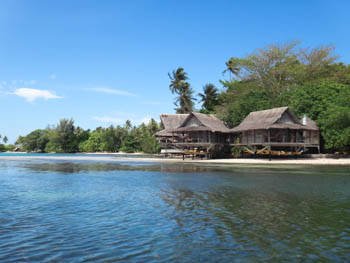
The first day we dinghied in for lunch a hornbill, named for its exaggerated and menacing beak, was standing on a long dining table. A man was sitting across from it. Both had plates of food in front of them. The man looked stern, defying the bird to touch his fries. Standing a safe distance behind her plate and the hornbill was a woman who had grown tired of battling with the belligerent beast.
So it is thanks to Mo, the hornbill, that we met Lisa Matisoo-Smith and Glenn Summerhayes from the University of Otago, New Zealand. Glenn is Head of the Dept. of Anthropology and Lisa is a professor of Biological Anthropology and Principal Investigator for Molecular Biology and Evolution.
Yes, we did indeed attempt to converse with these two. Fortunately, as professors do, they did most of the talking. Glenn has worked in various locations in PNG over the last 30 years. Lisa has been working on Emerau, an island near here, since 2007. There is even a little girl there named after her.
They told us about their ongoing work. I won't go into that, but will relate some information they gave us about the people of Papua New Guinea, how and when the arrived, and of this area in particular. They also told us about the travels of these peoples' ancestors ... right across the Pacific in sailing canoes. Lisa was kind enough to share two papers with us - Voyaging by canoe and computer: experiments in the settlement of the Pacific Ocean, and Untangling Oceanic settlement: The edge of the knowable.
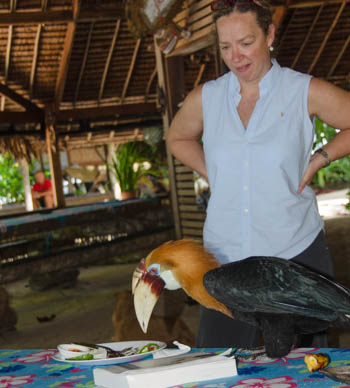
I've run out of time to recap the information we received from Lisa and Glenn but will finish this page we get to Palau in October. It's fascinating. Check back!
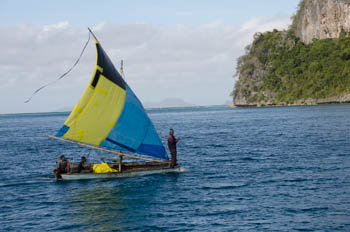
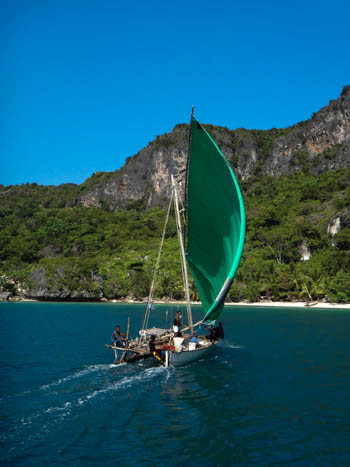
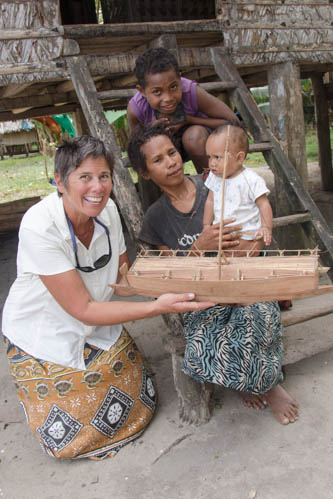
Go to September 2013 Part One - Kaeieng, New Ireland, Papua New Guinea
